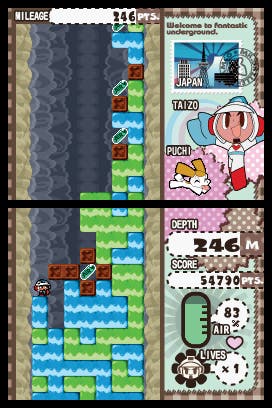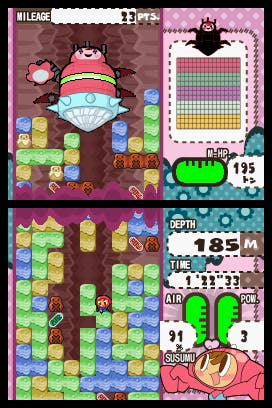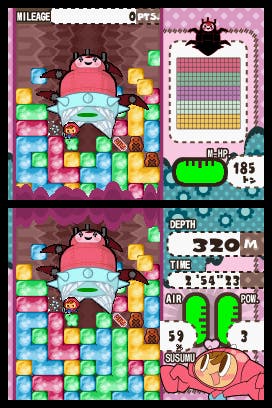Mr. DRILLER: Drill Spirits
We can be happy underground. Mostly.
"Project Rub could be for the DS what Tetris was to the Game Boy."
We've paraphrased it somewhat, but that is roughly what SEGA is saying about the Nintendo DS launch title known to Japanese and American audiences as Feel the Magic, which we reviewed last week.
We disagree. Feel the Magic is a neat arrangement of small, stylus, microphone and dual screen-oriented tasks that more often than not take admirable strides down the new paths Nintendo's fledgling handheld hopes to drive developers. But, while it's generally satisfying for as long as it lasts, it's hardly comparable to the cross-generational, cross-gender appeal of Alexey Pajitnov's seminal line-smashing monochrome puzzler.
Neither's Mr. DRILLER: Drill Spirits, for that matter, but the point is that despite taking a less committed stance on the DS's new features (gingerly testing its weight on the dual screen pathway, and dabbling with the stylus) this is still far more worthy of the lavish praise that innocent statement clearly represents. As little as it changes from day to day, as much as it frustrates you, and as often as you fail, you still keep coming back. Without hesitation. Surely that's a lot closer to the Pajitnov's puzzling epiphany than a frequently sexist digitisation of someone's ideas notepad?
Air raising

But these are higher-level puzzle sensations. What's interesting about Mr. DRILLER, for those who haven't encountered it before, is that the fundamentals are more complex than you might expect from a puzzle game that manages to be this compulsive. The basic idea is to have your little character descend through a column of coloured squares, using either the stylus or one of the face buttons to knock through adjacent squares, until you reach a certain depth. But there's plenty more. Any touching squares of the same colour will also disappear, and if any of the squares above them are subsequently undermined, after a couple of seconds they'll fall down to close the gap, or at least as far as they can go before sticking to a same-coloured square on either side of their downward path.
With us so far? This is where it gets a bit more complicated. As you dig, you are constantly running out of air, as indicated by a little meter on the right of the screen, and to keep topping it up you'll have to get at various air capsules dotted around the play area. And of course you'll have to do this without getting crushed by dislodged squares above - if you run out of air you lose a life, of which you only have a meagre three by default, but if you're crushed by tumbling debris the effect is the same.
Further complicating matters are dark brown squares, which take several strikes to break through and take a great chunk out of your air total if you decide to do so - just as much, in fact, as you'll gain for grabbing capsules. As such, getting to the capsules becomes a little puzzle in itself, as you're often forced to consider how to make the little cluster of dark squares vanish by careful undermining, which gets harder as your air starts to run lower and the literal mountain of concerns stacked on top of you starts to tumble less forgivingly.
Block rocking

Another concern is your score. As you're often striving to reach a set depth, you'll want to try and score big while you can by introducing chain reactions as you descend. To do this, you'll have to get squares to fall so that they complete groups of four or more same-coloured squares, and preferably in turn dislodge different-coloured squares above them which then fall into groups of their respective colours and destroy them too. However, when you're weaving to try and collect air capsules and avoid dark squares, and struggling to keep yourself from being crushed, strategising to that extent can often seem impossible.
So your concerns are many, and, unlike Tetris where taking advantage of the design to ensure the biggest score was as simple as keeping a side channel open for a four-square-tall column to wipe the rest out, the myriad potential pitfalls here make for a much more complex and challenging undertaking - demanding a much higher level of planning to keep the route clear. And while panic in Tetris was fostered by increased speed and rising squares, here it's the twin dangers of flattening and asphyxiation that get your heart rate up and have you bashing through square after square, often before you've had a chance to weigh up the consequences of doing so, because not doing so would be even worse. Allowing you to nip into the gap created by a blitzed square and gather a capsule or drill adjacent areas before darting out of the path of the soon-to-fall bock you'd dislodged above is another stroke of genius.
Typically, having given you a target depth, the developer splits the levels into chunks a hundred or a few hundred metres deep, and just to keep you on your toes each chunk varies in terms of colours and the general layout of the squares - some are very fiddly, with lots of different-coloured squares mingling together unhelpfully, often hiding air capsules in horseshoe-shaped clusters of dark squares, while others are full of lots of same-coloured clusters that are very liable to chain reactions when you dig them out.
And that, as existing Mr. DRILLER fans now thoroughly bored of reading this are well aware, is how Namco's puzzler basically works. There can be few complaints about the default Mission Driller mode as we've explained it above; once you get to grips with it, it's one of the most essential games in the genre. Since we haven't had a decent Mr. DRILLER game in these parts for many a year, recommending it on this basis alone is a serious consideration.
Dug less

But, naturally, Drill Spirits on the Nintendo DS extends itself in some new directions. Apart from allowing you to unlock new characters with different attributes (e.g. a dog who can climb up two-square-tall steps, or a robot who can survive one crushing blow more than anybody else), Namco also includes stylus control, use of the second screen, and new game mode called Pressure Driller - in addition to a Time Attack mode that has you trying to clear a certain (usually shallow) depth by drilling like a maniac and collecting all the clock-shaped icons on the way to finish within the time limit. There's also a Drill Shop, which becomes crucial as you make progress, but we'll get to that later.
Disappointment over DRILLER's stylus control seems to have condemned Drill Spirits to the realms of mediocrity in the eyes of some reviewers. Then again, having disagreed with SEGA once already today, we're not going to shy away from arguing with our peers. Yes, stylus control is not as precise or discerning as simply using the D-pad to direct your little driller and the face buttons to clear squares, but a single arguably redundant control scheme can't crush our Drill Spirits. Likewise the addition of a second screen. It may not be utterly essential in Mission Driller mode to be able to see two screens' worth of squares to judge where things are falling, but it does have its moments, and, as we're about to see, it's absolutely critical in the new Pressure Driller game mode.
Pressure Driller is a highlight amongst highlights. Here the goal is not to reach a certain depth, but to kill a big drill advancing downwards on the top screen - drilling manically to avoid being caught up and corkscrewed, and collecting fireball capsules to fire upwards and do damage. Complicating matters somewhat, as ever, are the twin problems of air and crushing, but, acknowledging the increased difficulty of this, Namco has given you more time to scrabble for air and doesn't kill you off for being crushed repeatedly. Instead you're just held up for a few seconds, which, while it can be fatal if you're close to getting caught, more often than not merely heightens the tension. But then... perhaps that's too forgiving, someone must have said, because another issue is that your pursuer is only susceptible to fireball blows when his little flowery protrusions are exposed in order, lest we forget, to shower your path in more dark-square obstacles. Cue frantic manoeuvring, scouring for capsules and, to acknowledge some more Tetris-like behaviour, trying to gather three fireball capsules before firing them, because multiples do more damage.
Chop shop

Between the three main single-player game modes, Drill Spirits offers much to entertain you. And we're still not done. Because, bless you Namco, there's also the Drill Shop. On the surface, this lets you sell items in exchange for your high score points. Items that give you more lives per level, more oxygen per pill, greater fireball power in Pressure Driller mode, and so on. But when you think about it, it's actually the game's equivalent of a panic button. And brings to the fore something we've been reluctant to mention up to now: this reviewer, entranced though he is by Drill Spirits, is actually really, really bad at it.
It's strange. We know how to play it, we obviously appreciate the nuances of how it works or we wouldn't be sitting here eulogising them. Yet we're a bit crap. But, hey, the key point here surely is that it hasn't been enough to turn us away. And the key question: why?
It's a pair of things. Partly, it's our being persistent (albeit profane), which means that eventually we'll bang the wall hard enough to knock through and, in this case, reach the next level. Awed by such immaculate puzzle design, we'll keep going out of a mixture of admiration and affection anyway. But not everyone is like us. Some will simply give up out of frustration; while others will be so good they'll want to keep going without the option of oiling the rails with the numerous tempting power-ups in the Drill Shop. And therein lies the second thing that compels us not only to play the game but to say nice things about it: if you activate power-ups and then use them to succeed at a certain task, you won't bank the points you generated in doing so, meaning that you can't head back to the shop to buy more.
At first, this struck us as bloody-minded. In some cases, we simply could not make progress without using power-ups. But the more we thought about it, the more it made sense. It's a simple, effective way of accommodating gamers of various skill levels without attaching stabilisers to everyone's bikes.
Holes

But nyaaaar! Just when you thought we'd gotten to the point where we turned around and whacked a huge score on Drill Spirits and burrowed off into the sunset, we're forced to admit that there are some inherent niggles and stupidities that conspire to rob the game of some of its brilliance. So we're sorry about that. We did get your hopes up, what with all that Tetris stuff and the wrangling with other reviewers. It's our way. Please come back.
What's wrong with it, then? Not too much, but enough in some cases. Firstly, we're angry with Namco for only letting us play wirelessly with our friends using multiple cartridges. We don't have more than one cartridge, idiots. Even sillier is the fact that the Japanese version works using just the one ala Mario 64 DS. Hell, the Japanese version has a whole other game mode too. That's clearly a blot on the mining records. Delving slightly deeper, we're also a little upset by one element of Pressure Driller's behaviour - the way it strips you of any accumulated fireballs when you're squashed. Okay, fine, in that situation we've clearly been crap, but we're already being knocked back a few seconds, so why compound our disadvantage by disarming us too? This design decision often makes the difference between narrow victory and a bawling tantrum on the floor at the end of ten minutes or so of burrowing in vain. Other than that, about the harshest things we can say are that the menu system and single-player "story" are rubbish, and that you'll probably finish everything it has to offer relatively quickly because you're so in love with it. Yes, that's a solid criticism, that.
Right. Straws sufficiently clutched at, we've just time for one last thing: Mr. DRILLER is nothing like Tetris. It's far more complex, and, well, you can see how it's not. But we stand by our assertion that it often works on the same levels, stimulating you in the same pleasurable way, and although Drill Spirits has been dismissed in some quarters for failing to make use of the DS's various new toys with any real gusto, and for being too similar to previous Japanese versions, we'd still argue that it's one of the DS's worthiest early puzzlers. We could not stop coming back to it, despite our early frustration, and we're beholden to Namco for its ingenious design in most respects - particularly the great leveller that is the Drill Shop.
Spiriting
With DS games retailing for something like $30 in the US, even at import prices we'd be satisfied with this. And since we had to buy this ourselves to review it, we can actually genuinely say that, instead of just guessing. If you want something to lighten a commute or keep you occupied between courses this Christmas, don't be dissuaded by the relatively indifferent reaction elsewhere - Drill Spirits may not use the DS's new features to conduct a symphony orchestra whilst penning sonnets and bringing democracy to Cuba, but when the underlying game is this gripping we refuse to sit around using its relative lack of invention as a stick to beat it with. Buy this, give it time, and you'll love it.

